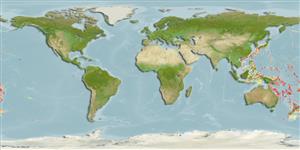>
Gadiformes (Cods) >
Macrouridae (Grenadiers or rattails)
Etymology: Lucigadus: Latin, lucius, Greek, lykos = wolf; pike + Latin, gadus = a fish cod?. By its predatory habits (Ref. 45335).
More on author: Günther.
Environment: milieu / climate zone / Tiefenbereich / distribution range
Ökologie
seewasser bathydemersal; tiefenbereich 204 - 600 m (Ref. 35908). Deep-water
Western Pacific: North Fiji Basin, Wallis and Futuna Islands, Norfolk Ridge, New Caledonia and Arafura and Madura seas.
Size / Gewicht / Alter
Geschlechtsreife: Lm ? range ? - ? cm
Max length : 16.0 cm TL Männchen/unbestimmt; (Ref. 35908)
Kurzbeschreibung
Bestimmungsschlüssel | Morphologie | Morphometrie
Rückenflossenstacheln (insgesamt) : 2. Prominent black blotch at tip of first dorsal fin; body with a banded pattern, the anal fin with distinct black margins under darkly banded areas; sides of head heavily peppered with large melanophores; few or no scales on branchiostegal and gular membranes.
Body shape (shape guide): elongated.
A benthic species found on the continental slope (Ref. 75154).
Life cycle and mating behavior
Geschlechtsreife | Fortpflanzung | Ablaichen | Eier | Fecundity | Larven
Iwamoto, T. and N.R. Merrett, 1997. Pisces Gadiformes: Taxonomy of grenadiers of the New Caledonian region, southwest Pacific. Mem. Mus. Natl. Hist. Nat. (176):473-570. (Ref. 35908)
IUCN Rote Liste Status (Ref. 130435: Version 2025-1)
Bedrohung für Menschen
Harmless
Nutzung durch Menschen
Tools
Zusatzinformationen
Download XML
Internet Quellen
Estimates based on models
Preferred temperature (Ref.
123201): 6.9 - 17.3, mean 11.3 °C (based on 185 cells).
Phylogenetic diversity index (Ref.
82804): PD
50 = 0.5039 [Uniqueness, from 0.5 = low to 2.0 = high].
Bayesian length-weight: a=0.00214 (0.00109 - 0.00421), b=3.20 (3.03 - 3.37), in cm total length, based on LWR estimates for this (Sub)family-body shape (Ref.
93245).
Trophic level (Ref.
69278): 3.4 ±0.4 se; based on size and trophs of closest relatives
Widerstandsfähigkeit (Ref.
120179): mittel, Verdopplung der Population dauert 1,4 - 4,4 Jahre. (Preliminary K or Fecundity.).
Fishing Vulnerability (Ref.
59153): Low vulnerability (10 of 100).
🛈
